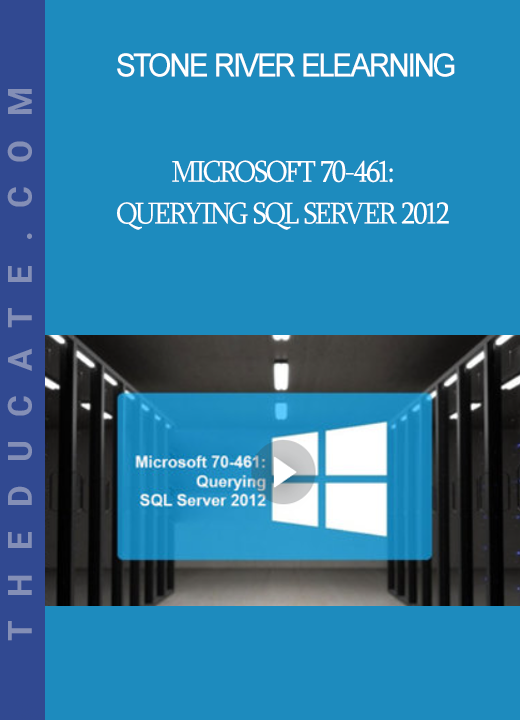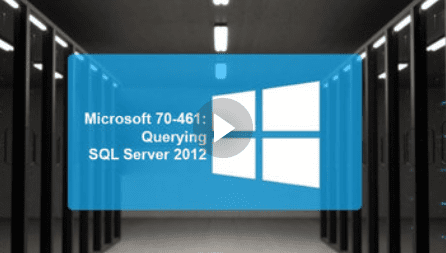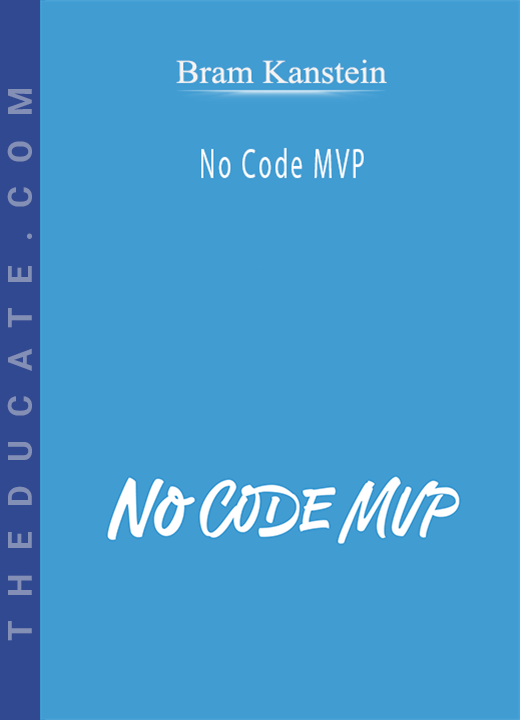Description
Stone River Elearning – Microsoft 70-461: Querying SQL Server 2012
This course is intended for SQL Server database administrators, implementers, system engineers, and developers. This new SQL 2012 course is focused on anyone interested in the validation of your skills and knowledge with writing queries.
This course provides the knowledge and understanding for some of these important job functions:
- Apply built-in scalar functions
- Apply ranking functions
- Combine datasets
- Creates and alters
- Design T-SQL stored procedures, views
- Implementing aggregate queries, error handling, sequence generation and data types
- Manage transactions
- Modify data by using INSERT, UPDATE, DELETE and MERGE statements
- Optimizing queries
- Query data using SELECT statements and Managing XML data
- OUTPUT clause to return data
This learning course provides the knowledge for the 70-461 Exam on Queries on Microsoft SQL Server 2012:
- Create Database Objects
- Create and alter tables using T-SQL syntax (simple statements).
- Create and alter views (simple statements).
- Design views.
- Create and modify constraints (simple statements).
- Create and alter DML triggers.
- Work with Data
- Query data by using SELECT statements.
- Implement sub-queries.
- Implement data types.
- Implement aggregate queries.
- Query and manage XML data.
- Modify Data
- Create and alter stored procedures (simple statements).
- Modify data by using INSERT, UPDATE, and DELETE statements.
- Combine datasets.
- Work with functions.
- Troubleshoot & Optimize
- Optimize queries.
- Manage transactions.
- Evaluate the use of row-based operations vs. set-based operations.
- Implement error handling.
We create the highest quality course curriculum possible, ensuring you receive the training and knowledge needed to succeed.
Course Curriculum
Querying Microsoft SQL Server 2012
- Course Introduction Part1 (1:25)
- Course Introduction Part2 (0:40)
- Course Modules (1:54)
Module 1
- Introduction to SQL Server 2012 Part1 (0:10)
- Introduction to SQL Server 2012 Part2 (0:22)
- Introduction to SQL Server 2012 Part3 (1:24)
- SQL Instances Part1 (5:05)
- SQL Instances Part2 (3:08)
- SQL Instances Part3 (1:53)
- Editions and Licensing Part1 (5:07)
- Editions and Licensing Part2 (1:02)
- SQL Server Objects (1:20)
- System Databases (4:11)
- SQL Server Data Tools (2:23)
- Object Explorer Part1 (0:49)
- Object Explorer Part2 (1:53)
- Object Scripting Part1 (0:48)
- Object Scripting Part2 (2:57)
- Template Explorer Part1 (0:55)
- Template Explorer Part2 (1:50)
- Query Tabs Part1 (0:36)
- Query Tabs Part2 (1:50)
- Projects and Solutions Part1 (0:48)
- Projects and Solutions Part2 (3:09)
- Customizing SSDT Part1 (0:39)
- Customizing SSDT Part2 (5:17)
- Debugging T-SQL Part1 (0:57)
- Debugging T-SQL Part2 (2:20)
- SQLCMD Part1 (2:17)
- SQLCMD Part2 (5:36)
- Exam Scenarios (3:01)
- Module Review (1:13)
Module 2
- T-SQL Overview Part1 (0:07)
- T-SQL Overview Part2 (1:15)
- T-SQL Overview Part3 (1:02)
- T-SQL Elements Part1 (0:17)
- T-SQL Elements Part2 (1:29)
- Batch Separators Part1 (1:11)
- Batch Separators Part2 (2:56)
- Line Terminator Part1 (0:31)
- Line Terminator Part2 (1:35)
- Variables Part1 (1:16)
- Variables Part2 (1:50)
- Control Flow Part1 (1:16)
- Control Flow Part2 (1:28)
- Expressions Part1 (0:56)
- Expressions Part2 (1:48)
- Functions Part1 (1:34)
- Functions Part2 (2:51)
- Predicates and Operators Part1 (1:37)
- Predicates and Operators Part2 (2:11)
- Predicates and Operators Part3 (0:56)
- SELECT Part1 (1:12)
- SELECT Part2 (1:41)
- SELECT Part3 (0:38)
- Column Aliasing Part1 (1:13)
- Column Aliasing Part2 (1:15)
- SELECT Execution Part1 (1:00)
- SELECT Execution Part2 (1:21)
- Exam Scenarios (2:54)
- Module Review (0:43)
Module 3
- SELECT Statements Part1 (0:09)
- SELECT Statements Part2 (0:09)
- Basic SELECT Statement Part1 (1:04)
- Basic SELECT Statement Part2 (1:22)
- Specifying Columns Part1 (0:45)
- Specifying Columns Part2 (1:51)
- Derived Columns Part1 (0:47)
- Derived Columns Part2 (1:20)
- Aliasing Columns Part1 (1:41)
- Aliasing Columns Part2 (1:09)
- Calculated Columns Part1 (1:11)
- Calculated Columns Part2 (1:46)
- Ordering Results Part1 (0:07)
- Ordering Results Part2 (0:51)
- Ordering Results Part3 (1:18)
- Ordering Results Part4 (1:03)
- Returning Distinct Results Part1 (1:53)
- Returning Distinct Results Part2 (1:53)
- Exam Scenarios (2:44)
- Module Review (0:48)
Module 4
- Filtering Part1 (0:13)
- Filtering Part2 (0:17)
- WHERE Syntax Part1 (1:26)
- WHERE Syntax Part2 (1:35)
- BETWEEN (1:19)
- WHERE Syntax IN (1:36)
- Filtering NULL Values (2:49)
- LIKE (1:54)
- Data Type Comparison (3:35)
- Filtering Data with WHERE Part1 (3:13)
- Filtering Data with WHERE Part2 (4:35)
- Filtering Data with WHERE Part3 (4:46)
- TOP Part1 (0:13)
- TOP Part2 (2:37)
- OFFSET-FETCH Part1 (2:07)
- OFFSET-FETCH Part2 (3:26)
- Exam Scenarios (2:26)
- Module Review (0:52)
Module 5
- Join and Set Operators (0:10)
- Using Joins Part1 (0:11)
- Using Joins Part2 (1:21)
- Categories of Joins (1:45)
- INNER JOIN (4:23)
- OUTER JOIN (3:39)
- JOIN Demo (6:43)
- Set Operators Part1 (0:08)
- Set Operators Part2 (1:26)
- Set Operators Part3 (1:13)
- Set Operators Part4 (0:45)
- Set Operators Demo (4:32)
- Exam Scenarios (2:40)
- Module Review (0:58)
Module 6
- Subqueries and Table Expressions (0:10)
- Subqueries Part1 (0:08)
- Subqueries Part2 (0:52)
- Self Contained Subquery (1:15)
- Correlated Subquery (0:43)
- Subquery Demo (3:39)
- EXISTS Part1 (0:07)
- EXISTS Part2 (1:21)
- EXISTS Part3 (2:06)
- Common Table Expressions Part1 (0:15)
- Common Table Expressions Part2 (2:42)
- Temporary Tables (2:27)
- Table Variables (2:47)
- Table Demo (5:41)
- Exam Scenarios (2:53)
- Module Review (1:22)
Module 7
- System Functions Part1 (0:12)
- System Functions Part2 (2:00)
- Scalar Functions (2:12)
- ROWSET (1:12)
- System Function Demo (3:22)
- Aggregate Functions Part1 (0:33)
- Aggregate Functions Part2 (2:27)
- DISTINCT (3:23)
- Aggregation Demo (4:56)
- GROUP BY Part1 (5:23)
- GROUP BY Part2 (7:33)
- HAVING Part1 (1:23)
- HAVING Part2 (2:27)
- Conversion Functions Part1 (0:12)
- Conversion Functions Part2 (2:51)
- Conversion Functions Part3 (2:44)
- Conversion Functions Part4 (6:10)
- Exam Scenarios (2:35)
- Module Review (2:05)
Module 8
- T-SQL Programming (0:16)
- Logical Functions Part1 (0:10)
- Logical Functions Part2 (1:00)
- IIF, CHOOSE and CASE (3:18)
- Logical Function Demo Part1 (2:34)
- Logical Function Demo Part2 (2:48)
- Using Views Part1 (0:28)
- Using Views Part2 (4:02)
- Stored Procedures (4:02)
- Functions (3:44)
- Triggers (2:26)
- Views Demo Part1 (4:35)
- Views Demo Part2 (6:55)
- Views Demo Part3 (4:46)
- TRY CATCH Part1 (0:08)
- TRY CATCH Part2 (2:23)
- Exam Scenarios (3:17)
- Module Review (1:28)
Module 9
- Transactions (0:10)
- Introduction to Transactions Part1 (0:08)
- Introduction to Transactions Part2 (3:35)
- INSERT and UPDATE (2:29)
- DELETE and TRUNCATE (2:46)
- Transactions Demo Part1 (4:51)
- Transactions Demo Part2 (3:53)
- Transactions Demo Part3 (3:35)
- Managing Transactions Part1 (0:13)
- Managing Transactions Part2 (3:41)
- XACT_ABORT (2:18)
- Managing Transactions Demo Part1 (4:46)
- Managing Transactions Demo Part2 (4:22)
- Exam Scenarios (2:01)
- Module Review (0:33)
Module 10
- Query Performance (0:09)
- Indexing Part1 (0:08)
- Indexing Part2 (3:59)
- Indexing Part3 (2:37)
- Index Strategies (3:24)
- Indexes Demo Part1 (4:06)
- Indexes Demo Part2 (4:20)
- Execution Plans part1 (0:11)
- Execution Plans Part2 (3:49)
- Statistics IO (1:12)
- Execution Plans Demo part1 (3:53)
- Execution Plans Demo part2 (3:46)
- Exam Scenarios (2:29)
- Module Review (1:24)
- Program Review (2:15)
Sale Page: https://stoneriverelearning.com/p/microsoft-70-461
Archive: https://archive.ph/wip/Edq6R







Reviews
There are no reviews yet.